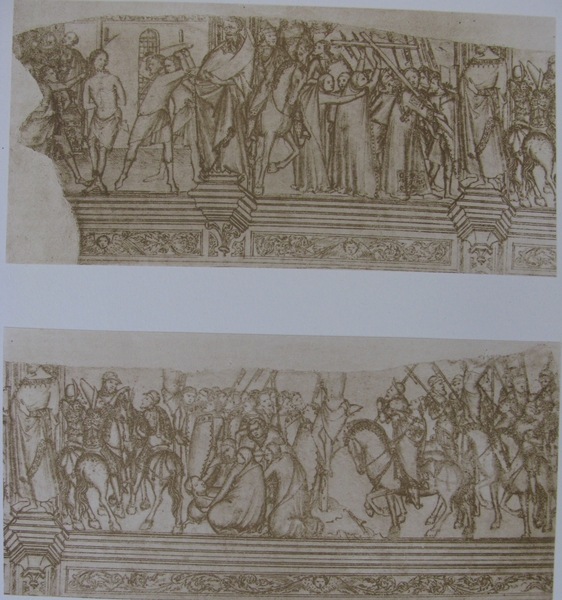Design for Pulpit
Summary
A reproduction produced by the Vasari Society of a fragment of a design for a pulpit from the Sienese School. This design has been split into two parts in order that the correct size may be maintained. This part of the design shows a frieze above a cornice displaying scenes from the Passion narrative of the Life of Christ. The part of the design positioned above shows the Flagellation of Christ followed by Christ carrying the Cross to Calvary. The section below continues on from this and shows the soldiers drawing lots for Christ's clothes, and Christ being taken off the Cross after death. Two figures of Saints separate the scenes in the section positioned above, and these stand forwards from the frieze. The accompanying booklet produced by the Vasari Society includes a short essay on the history of the designs for this pulpit, which were never carried out. This essay belongs to No.s 23-25 in the catalogue (accession numbers 1932.69/23a, 1932.69/23b, 1932.69/24 and 1932.69/25 in the Manchester City Art Gallery catalogue). Heading in the Vasari Society booklet: "Nos. 23-25 SIENESE SCHOOL, XIVTH CENTURY DESIGN FOR A PULPIT FOR ORVIETO CATHEDRAL NEVER CARRIED OUT Three fragments, at Orveito, London and Berlin. Pen and bistre on vellum. Original dimensions about 60 x 150 cm. (24 x 58 in.)" Text from the accompanying booklet produced by the Vasari Society for this individual design: "Second Fragment (No. 24) British Museum, 1899-6-17, purchased from Miss Warnecke. 11.2 x 41.3 cm. (4 3/8 x 16 1/4 in.) (Here, again, the drawing has been divided into parts to avoid reduction, the statue which divides the two sides being repeated.) In this case only the parapet and the cornice and frieze below it have been preserved, while the drawing is torn at the left end and along the top, and cut short at the right end. The subjects are the Scourging of Christ and Procession to Calvary (fifth side), and the Crucifixion, which occupies a double space, the whole of the sixth side. It is not at first sight clear that this fragment is the immediate continuation of the principal sheet at Orvieto, and a gap might be suspected for two reasons. In the first place, the fourth side does not end, as we might expect it to for the sake of symmetry, with a pair of statues to match those at the end of the second side, and a doubt might arise on this score as to the number of sides that the pulpit really contained. Against this objection it may be urged that such a demand for symmetry is excessive; the architect may have intended a pair of statues to appear only at the angle from which the preacher addressed the congregation, and not on the side towards the choir. In the second place, there is apparently a wide gap in sequence of subjects between the Betrayal by Judas and the Scourging. It will be noticed, however, that the Betrayal itself follows immediately on the Last Supper, without any representation of the Agony in the Garden, which might seem one of the most indispensable subjects in a Passion series of many scenes. The designer has left something to the imagination of the faithful. Now, on looking closely at the extremity of the Orvieto drawing, it will be seen that the torn edges correspond approximately, though not exactly, to those of the London fragment. What is more significant, the Orvieto drawing contains the right arm, thrown back and raised in the act of aiming a stroke, of the gaoler who stands on the extreme left in the London drawing. The left end of the latter sheet is so much blurred that the rod or scourge which the gaoler wields cannot be discerned; the principal subject at the left end seems to be a group of figures, Pilate on his throne with attendants; and the head of a subordinate figure in this group is distinctly visible on the Orvieto fragment. Moreover, the latter contains enough of the wall of the room in which the scourging takes place for the decoration at the top to be made out. This consists of two parts, forming a double frieze, or frieze and cornice, beneath the main cornice of the parapet itself. The lower part of this frieze is continued on the London fragment. It is important to observe these minute details, as they prove that there is no gap in the series of Passion scenes as we now possess them, and thus confirm the reconstruction of the proposed pulpit."
Object Name
Design for Pulpit
Creators Name
Date Created
1905-1906
Dimensions
support: 45.6cm x 38.1cm
accession number
1932.69/24
Collection Group
Medium

